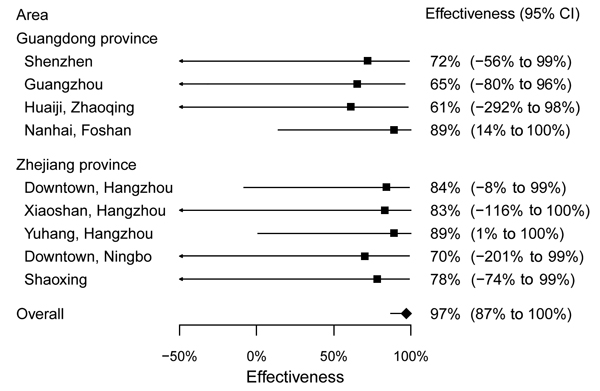Poultry Market Closures and Human Infection with Influenza A(H7N9) Virus, China, 2013–14
Peng Wu
1, Hui Jiang
1, Joseph T. Wu
1, Enfu Chen
1, Jianfeng He
1, Hang Zhou, Lan Wei, Juan Yang, Bingyi Yang, Ying Qin, Vicky J. Fang, Ming Li, Tim K. Tsang, Jiandong Zheng, Eric H. Y. Lau, Yu Cao, Chengliang Chai, Haojie Zhong, Qiao Sun, Gabriel M. Leung, Luzhao Feng, George F. Gao, Benjamin J. Cowling
2, and Weizhong Yang
2
Author affiliations: School of Public Health, Li Ka Shing Faculty of Medicine, The University of Hong Kong, Hong Kong Special Administrative Region, China (P. Wu, J.T. Wu, L. Wei, B. Yang, V.J. Fang, T.K. Tsang, E.H.Y. Lau, G.M. Leung, B.J. Cowling); Division of Infectious Disease, Key Laboratory of Surveillance and Early-warning on Infectious Disease, Chinese Center for Disease Control and Prevention, Beijing, China (H. Jiang, H. Zhou, J. Yang, Y. Qin, M. Li, J. Zheng, Y. Cao, Z. Li, L. Feng, H. Yu); Zhejiang Provincial Centre for Disease Control and Prevention, Hangzhou, China (E. Chen, C. Chai); Guangdong Provincial Centre for Disease Control and Prevention, Guangzhou, China (J. He, H. Zhong); CAS Key Laboratory of Pathogenic Microbiology and Immunology, Institute of Microbiology, Chinese Academy of Sciences, Beijing (G.F. Gao); Office of Director-General, Chinese Center for Disease Control and Prevention, Beijing (G.F. Gao)
Main Article
Figure 2

Figure 2. Estimates of the effect of interventions in reducing human risk for infection with avian influenza A(H7N9) virus in urban areas of Guangdong and Zhejiang provinces. Estimates are presented as effectiveness, calculated as 1 minus the ratio of incidence rates of infection after closure versus before closure, within 95% confidence intervals. Estimates are shown for each urban area, and a single summary measure is also shown assuming the effectiveness was the same across all areas. For Huaiji County and Nanhai District, live poultry markets (LPMs) epidemiologically linked to confirmed H7N9 cases were closed a few days before all the other local LPMs were closed. To account for differential start dates of LPM closure within these areas, we performed sensitivity analysis by setting the overall start date of LPM closure in a given area to be either the earliest or the last day on which local LPMs began to close. Results in the 2 scenarios were similar.
Main Article
Page created: October 17, 2014
Page updated: October 17, 2014
Page reviewed: October 17, 2014
The conclusions, findings, and opinions expressed by authors contributing to this journal do not necessarily reflect the official position of the U.S. Department of Health and Human Services, the Public Health Service, the Centers for Disease Control and Prevention, or the authors' affiliated institutions. Use of trade names is for identification only and does not imply endorsement by any of the groups named above.
